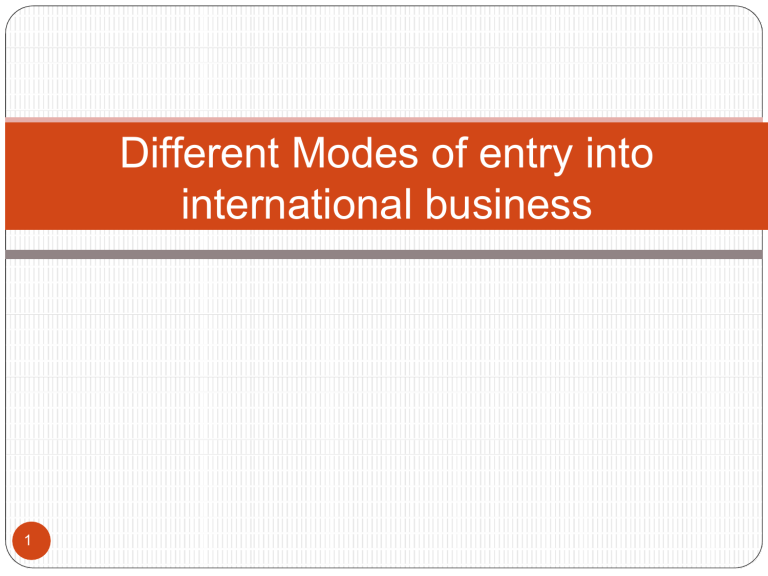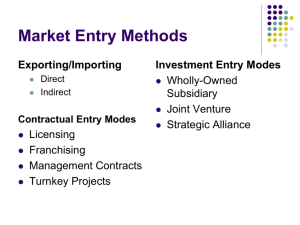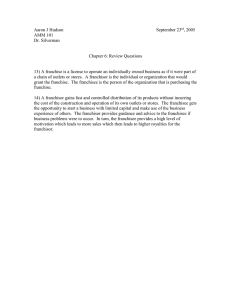
Different Modes of entry into international business 1 Different modes of entry ⚫ Exporting ⚫ Licensing ⚫ Franchising ⚫ Contract manufacturing ⚫ Management Contracts ⚫ FDI without alliances ⚫ FDI with alliances 2 Forms of Exporting 1 2 3 3 • Indirect Exporting • Direct Exporting • Intra-corporate Transfers Forms of Exporting ⚫Exporting means shipping the goods and services out of the port of a country. Seller is referred to as an "exporter" . Buyer is referred to as an "importer“. ⚫Indirect Exporting means that the firm participates in international business through an intermediary and does not deal with foreign customers or markets. ⚫Direct exporting means that the firm works with foreign customers or markets with the opportunity to develop a relationship. 4 Indirect Exporting 5 Indirect Exporting – Eg. ⚫Exporting of goods and services through various home-based exporters ⚫Manufacturers’ export agents ⚫Export commission agents ⚫Export merchants ⚫International firms 6 Direct Exporting 7 Intra-corporate Transfer 8 Exporting Advantages Relatively low financial exposure Permit gradual market entry Acquire knowledge about local market Avoid restrictions on foreign investment 9 Disadvantages Vulnerability to tariffs and NTBs Logistical complexities Potential conflicts with distributors Licensing ⚫ Licensing is when a firm, called the licensor, leases the right to use its intellectual property—technology, work methods, patents, copyrights, brand names, or trademarks—to another firm, called the licensee, in return for a fee. ⚫ The property licensed may include: ⚫Patents ⚫Trademarks ⚫Copyrights ⚫Technology ⚫Technical know-how ⚫Specific business skills 10 The Licensing Process 11 Basic Issues in International Licensing ⚫ Specifying the boundaries of the agreement ⚫ Determining compensation ⚫ Establishing rights, privileges, and constraints ⚫ Specifying the duration of the contract ⚫Differences in laws and culture. Eg. Pepsico, Coke Bottling Plant 12 Licensing –Adv. & Disadv. Advantages • Low financial risks • Low-cost way to assess market potential • Avoid tariffs restrictions on foreign investment • Licensee provides knowledge of local markets 13 Disadvantages • Limited market opportunities/profits • Dependence on licensee • Potential conflicts with licensee • Possibility of creating future competitor Franchising ⚫ Under franchising, an independent organization called the franchisee operates the business under the name of another company called the franchisor. ⚫ In such an arrangement the franchisee pays a fee to the franchisor. ⚫ Franchising is a form of Licensing but the Franchisor can exercise more control over the Franchisee as compared to that in Licensing. 14 Franchising Agreements ⚫ Franchisee has to pay a fixed amount and royalty based on sales. ⚫ Franchisee should agree to adhere to follow the franchisor’s requirements ⚫ Franchisor helps the franchisee in establishing the manufacturing facilities ⚫ Franchisor allows the franchisee some degree of flexibility. ⚫ Eg. McDonalds, Subway, KFC 15 Franchising- Adv. & Disadvantages Advantages ⚫ Low financial risks ⚫ Limited market ⚫ Low-cost way to assess opportunities/profits ⚫ Dependence on franchisee ⚫ Potential conflicts with franchisee ⚫ Possibility of creating future competitor market potential ⚫ Avoid tariffs, restrictions on foreign investment ⚫ Maintain more control than with licensing ⚫ Franchisee provides knowledge of local market 16 Disadvantages FDI without alliances Companies enter the international market through FDI , invest their money, establish manufacturing and marketing facilities through ownership and control. Greenfield strategy- the term Greenfield refers to starting of the operations of a company from scratch in a foreign market. 17 Greenfield Strategy Advantages Disadvantages 19 • • • • Best site Modern facilities Economic development incentives Clean slate • Huge time and patience needed • Expensive • Comply with local and national regulation • Local workforce needed • Strongly perceived as a foreign worker FDI with strategic alliances Strategic alliance is a cooperative and collaborative approach to achieve the larger goals. Role of alliances ⚫ Many complicated issues are solved through alliances ⚫ They provide the parties each other’s strengths ⚫ Helps in developing new products with the interaction of 2 or more industries ⚫ Meet the challenges of technological revolution. ⚫ Managing heavy outlay ⚫ Become strong to compete with a multinational company. 20 FDI with strategic alliances Modes of FDI through alliances are: ⚫ Merger : The combining of two or more companies, generally by offering the stockholders of one company securities in the acquiring company in exchange for the surrender of their stock. ⚫ Acquisition : When one company takes over another and clearly established itself as the new owner, the purchase is called an acquisition. ⚫ Joint ventures is an entity formed between two or more parties to undertake economic activity together. The parties agree to create a new entity by both contributing equity, and then they share in the 21 revenues, expenses, and control of the enterprise. Examples Merger 21 Acquisition ⚫ ING Vysya merged into ⚫ Flipkart acquired Kotak Mahindra ⚫ Ranbaxy into Sun Pharma ⚫ Tata Chemicals took over British salt based in UK Myntra ⚫ Yahoo acquired Bookpad ⚫ Asian paints acquired front end sales of Ess Ess bathroom Products ⚫ ICICI Bank's acquisition of Bank of Rajas Acquisition Advantages ⚫ Obtains control over the acquired firm such as factories and brand names ⚫ Integrate the mgt of the firm into its overall international strategy 22 Disadvantages ⚫ Assumes all the liabilities such as financial and managerial Joint Ventures Advantages 23 Disadvantages ⚫Benefit from local ⚫Risk giving control of partner’s knowledge. ⚫Shared costs/risks with partner. ⚫Reduced political risk. technology to partner. ⚫May not realize experience curve or location economies. ⚫Shared ownership can lead to conflict





